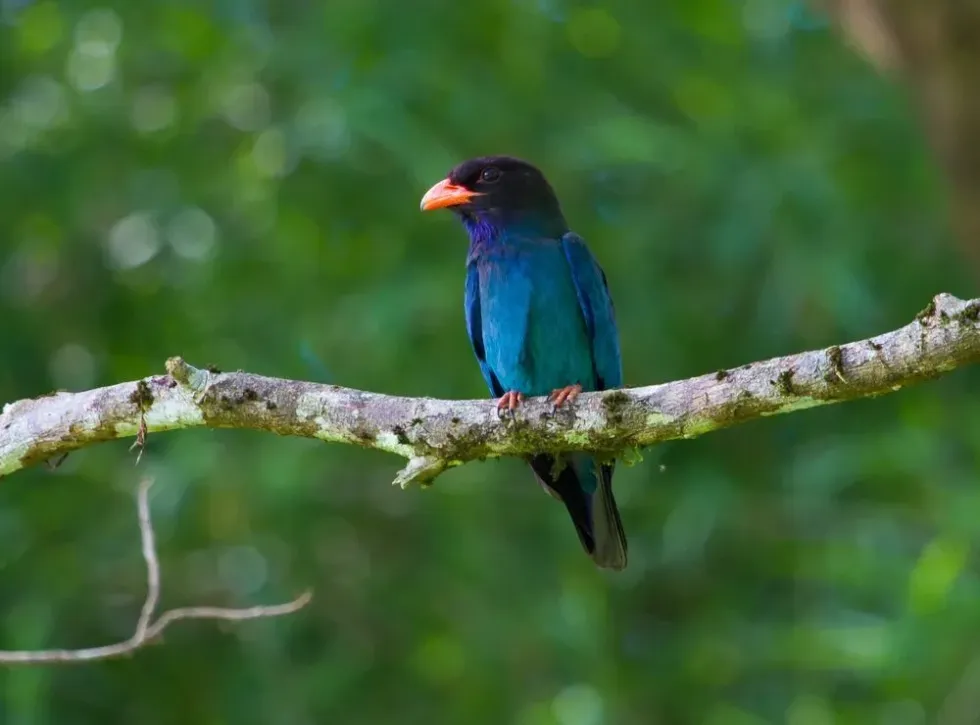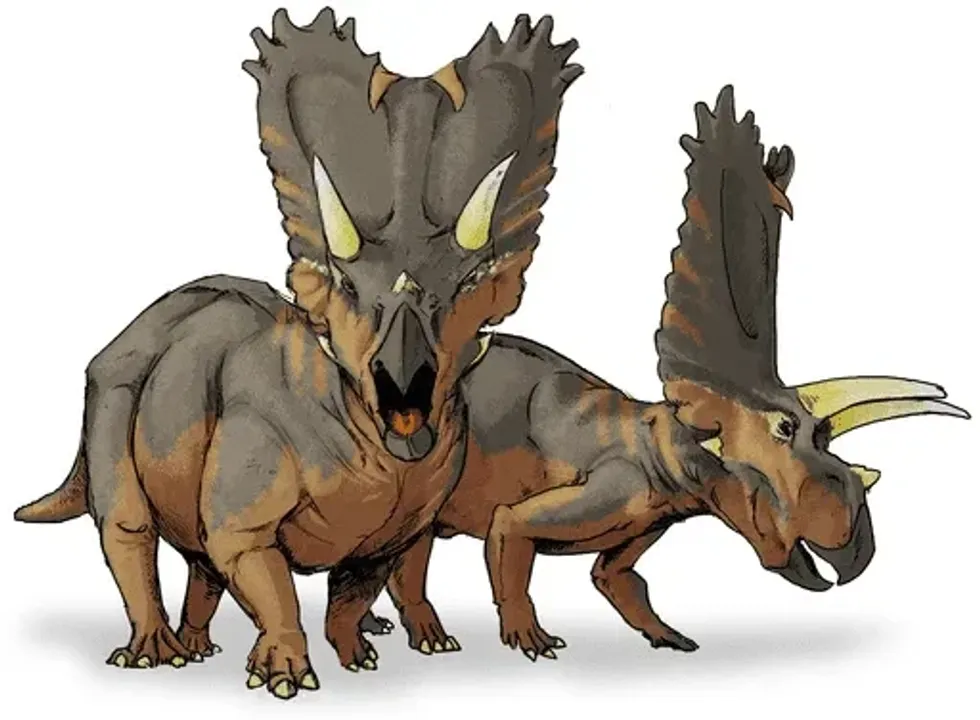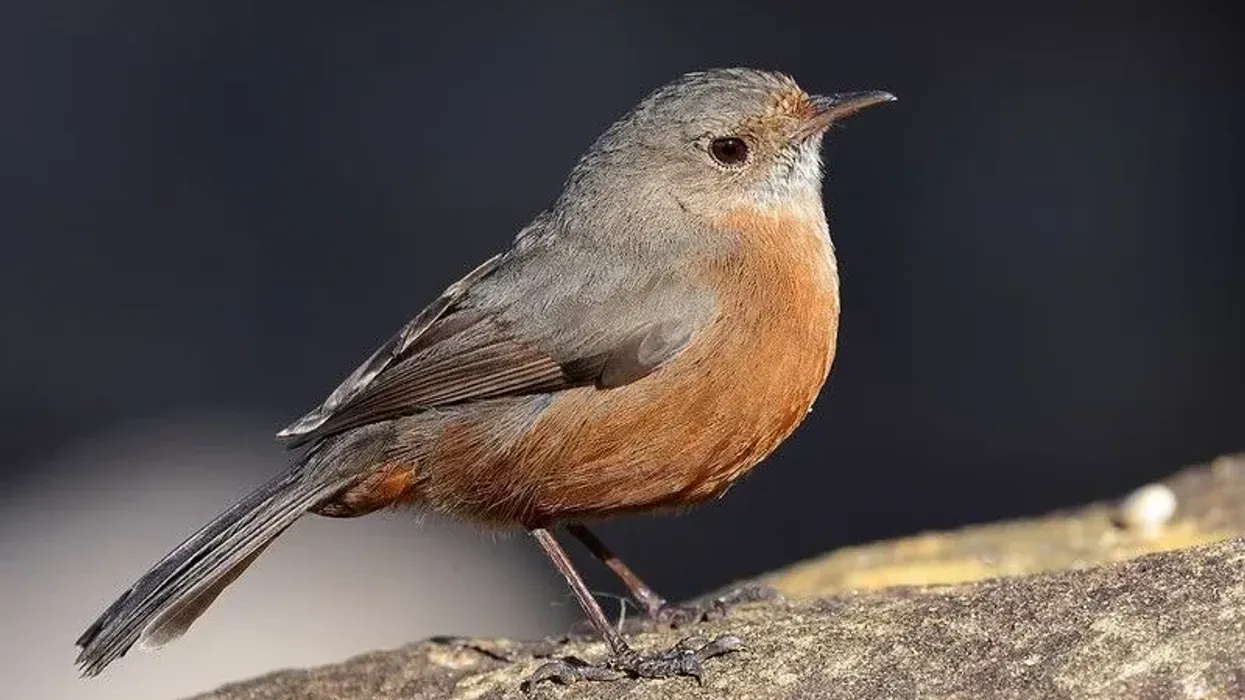The Oriental dollarbird (Eurystomus orientalis) is a roller bird found in the regions of Asia, Australia, and some islands in Oceania. The Oriental dollarbird derives its name from the white dollar-coin-shaped spots it has on either underwing.
This medium-size blue bird is spread over a wide geographic range. The countries it is found in include India, Bangladesh, China, South Korea, Russia, Vietnam, Australia, the Philippines, and Papua New Guinea.
The Oriental dollarbird (Eurystomus orientalis) is migratory. The breeding birds from China, Russia, and Japan move to Southeast Asia in the winter.
The Oriental dollarbird lives in different habitat types including lowland forests, pasturelands, urban gardens, farmlands, parks, and montane forests. This bird inhabits elevations of up to 4,921 ft (1,500 m).
Another prominent thing about the Oriental dollarbird species is the rolling flight of the pairs and the harsh 'kak-kak-kak' calls. It is listed as a Least Concern species on the IUCN's Red List.
For more relatable content, check out these flycatcher interesting facts and hummingbird facts for kids.
Oriental Dollarbird Interesting Facts
What type of animal is an Oriental dollarbird?
The Oriental dollarbird (Eurystomus orientalis) is a bird.
What class of animal does an Oriental dollarbird belong to?
The Oriental dollarbird (Eurystomus orientalis) belongs to the Aves class of animals.
How many Oriental dollarbirds are there in the world?
The exact population of the Oriental dollarbird (Eurystomus orientalis) species in the world is not known since their populations have not been quantified. They are pretty common throughout their extensive habitat range.
Where does an Oriental dollarbird live?
The Oriental dollarbird (Eurystomus orientalis) is found in Asia, Australia, and some islands in Oceania.
The Oriental dollarbird range includes the regions of India, Bangladesh, Nepal, Bhutan, Japan, China, South Korea, North Korea, Russia, south-eastern Siberia, Thailand, Myanmar, Laos, Cambodia, Vietnam, Singapore, Malaysia, Brunei, Australia, Indonesia, the Philippines, Timor-Leste, and Papua New Guinea.
The Oriental dollarbird (Eurystomus orientalis) species is mostly migratory. The breeding populations in countries like China, Russia, and Japan move to the nations in Southeast Asia or India for the winter. Southeast Asia itself has many breeding populations. Also, Oriental dollarbirds that breed in Australia undergo northern migration to New Guinea and other nearby islands in winter.
What is an Oriental dollarbird's habitat?
The Oriental dollarbird (Eurystomus orientalis) is found in many different ecosystem and habitat types, both natural and artificial. This medium-sized bird is known to be found in open wooded areas, moist lowland forests, pasturelands, plantations, rural gardens, urban gardens, farmlands, and parks.
The Oriental dollarbird (Eurystomus orientalis) is also seen in subtropical and tropical montane and submontane forests as well as in shrublands. This bird lives at elevations of 0-4,921 ft (0-1,500 m).
Who do Oriental dollarbirds live with?
The Oriental dollarbird (Eurystomus orientalis) species is known to live by itself or in pairs during the breeding season. This bird is also known to form feeding groups or migratory flocks of 50 or more birds.
How long does an Oriental dollarbird live?
Oriental dollarbirds (Eurystomus orientalis) are likely to live for close to 20 years in their wild habitats.
How do they reproduce?
The Oriental dollarbird (Eurystomus orientalis) species reproduce by mating and egg-laying.
The breeding season in northern and eastern Australia is from September to March/April, May to June in Japan, and from March to May in India. Trees, cavities, abandoned woodpecker holes, and rock crevices are chosen as places for nesting.
Three to five white Oriental dollarbird eggs are laid in unlined nests in trees or crevices. The nesting duties such as incubation and taking care of the hatchlings are shared among both the male and the female.
The Oriental dollarbird (Eurystomus orientalis) species will likely use the same nest for multiple years. Also, as a courtship display, the males will feed the females.
What is their conservation status?
The conservation status of the Oriental dollarbird (Eurystomus orientalis) species according to the International Union for Conservation of Nature is Least Concern.
Oriental Dollarbird Fun Facts
What do Oriental dollarbirds look like?
The Oriental dollarbird (Eurystomus orientalis) is a roller bird of medium size. The overall color of the Oriental dollarbird feathers is bright blue. The face, chin, crown, and nape are a dark bluish-brown color.
The wing and back coverts tend to have a bluish-green sheen. The undertail coverts, breast, and belly of the Oriental dollarbird are pale blue whereas the undertail and throat are bright blue. The primaries have underside patches that are light blue and the flight feathers tend to be dark blue.
The most prominent feature of the Oriental dollarbird (Eurystomus orientalis) species is the white 'dollar' circle it has on either of the under-wings.
The bill of the Oriental dollarbird (Eurystomus orientalis) is wide and short. The adults have a reddish-orange bill that has a black curved tip. The juveniles have a brownish-orange bill. The feet of the adults are red and those of immature dollarbirds are brownish-orange. The throat of the juveniles is whitish.
Oriental dollarbirds have black irises. Female dollarbirds have an overall duller plumage than the males.

How cute are they?
The Oriental dollarbird (Eurystomus orientalis) is a beautiful and stunning bird. The bird has beautiful contrasting features with a darker blue body and lighter feet and bill. The bird looks magnificent and almost iridescent in flight and the eponymous white 'dollar' signs are gorgeous embellishments.
How do they communicate?
The Oriental dollarbird (Eurystomus orientalis) communicates through displays and calls.
In the breeding season, pairs are seen engaging in 'rolling flights', mostly in the evenings. Loud cackling calls accompany a rolling flight. Pairs are also seen parading towards one another, with their feathers fluffed and their necks arched, curtsying and bobbing while uttering low calls.
Male birds have also been observed rubbing their bills around the head of the females while calling. The morning calls and displays include loud chatterings in unison and head and tail bobbing. This display is usually seen before mating.
The call of the Oriental dollarbird (Eurystomus orientalis) is a harsh, repetitive, and distinctive 'kak-kak-kak', mostly given in flight. This is also the contact and territorial call, while the perching call of the bird is more a shorter 'kak-kakek'.
How big is an Oriental dollarbird?
The Oriental dollarbird (Eurystomus orientalis) is 9.8-11.8 in (25-30 cm) long, which makes it four times bigger than Costa's hummingbirds.
How fast can an Oriental dollarbird fly?
Being a medium-sized bird, the Oriental dollarbird (Eurystomus orientalis) may fly at speeds close to 25 mph (40 kph).
How much does an Oriental dollarbird weigh?
The Oriental dollarbird (Eurystomus orientalis) weighs 3.9-6.7 oz (110-190 g).
What are the male and female names of the species?
Males and females of the Oriental dollarbird (Eurystomus orientalis) species do not have any specific names.
What would you call a baby Oriental dollarbird?
An Oriental dollarbird baby is called a chick.
What do they eat?
The Oriental dollarbird (Eurystomus orientalis) eats insects, grasshoppers, locusts, moths, spiders, butterflies, wasps, bugs, mantids, crickets, cicadas, lizards, and beetles.
Predators of the bird include snakes, hawks, goannas, eagles, and kookaburras.
Are they dangerous?
No, Oriental dollarbirds (Eurystomus orientalis) are not dangerous at all. These birds often frequent human-populated urban areas.
Would they make a good pet?
No, Oriental dollarbirds (Eurystomus orientalis) would not make good pets. These birds are not often kept in captive zoos, apart from a few zoological and bird communities that are able to keep Oriental dollarbirds, one of which is the San Diego Zoo.
Did you know...
Other names of the Oriental dollarbird include Asian dollarbird, dollarbird, broad-billed roller, dollar roller, and dark roller.
The Oriental dollarbird family has 10 total subspecies. The subspecies all have different geographic ranges. The subspecies also show slight variations in size and coloration.
The Oriental dollarbird belongs to the order Coraciiformes, the family Coraciidae, and the genus Eurystomus. Other birds to belong to the Coraciidae family and genus Eurystomus are the blue-throated roller, broad-billed roller, and the Azure dollarbird.
How did Oriental dollarbirds get their name?
The 'Oriental' in the name comes from the fact that these birds are native to much of the Asian continent, particularly the southern and eastern regions. The 'dollarbird' comes from the Oriental dollarbird appearance because these birds have dollar coin-shaped, white or pale blue spots on the under-wings.
Are Oriental dollarbirds endangered?
No, Oriental dollarbirds (Eurystomus orientalis) are not Endangered. This bird family is listed as a Least Concern species according to the IUCN.
Here at Kidadl, we have carefully created lots of interesting family-friendly animal facts for everyone to discover! Learn more about some other birds from our Anna's hummingbird facts and giant cowbird fun facts for kids pages.
You can even occupy yourself at home by coloring in one of our free printable Philippine fairy-bluebird coloring pages.
Photo by N. A. Naseer









